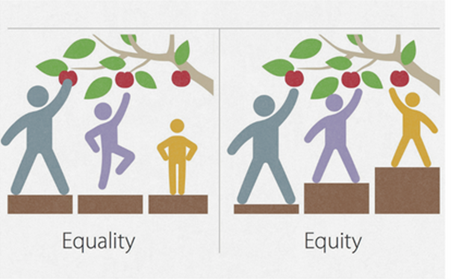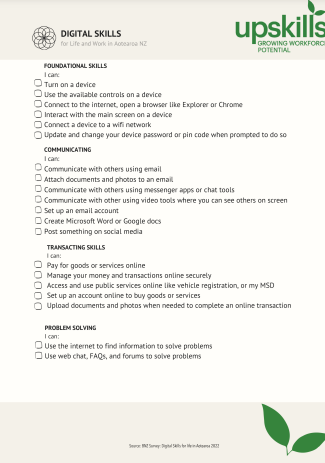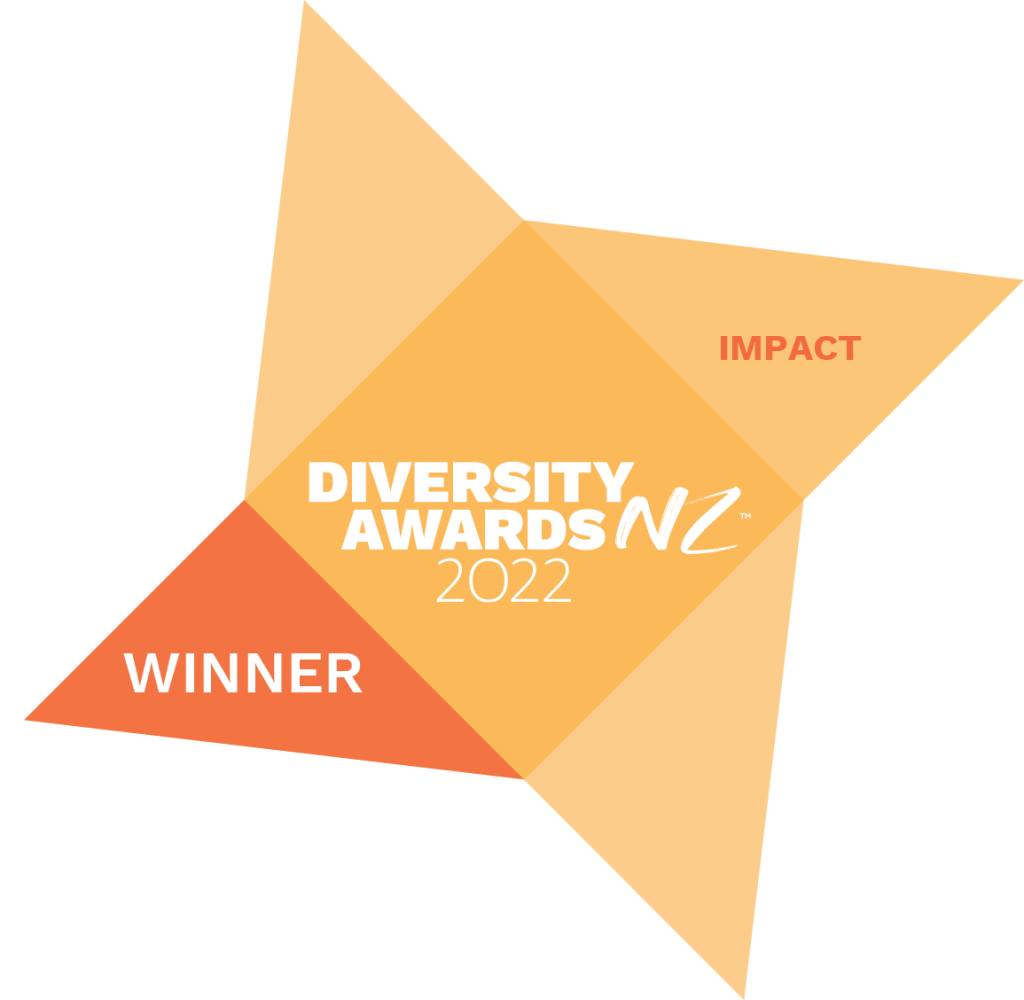What is equity?
Before we turn to digital equity it’s useful to consider what we mean by equity more broadly.

When we treat everybody the same (equality), we can see that some automatically access more opportunities, resources, or in this instance juicy red apples. When we see the second image of equity, everyone can easily reach the fruit, the resources, the opportunities and the power.
What is digital equity?
So in turning now to digital equity, the fruit is things like access to the internet, digital devices and skills. In New Zealand, we use the handy acronym MAST which stands for Motivation, Access, Skills and Trust. All parts of the MAST need to be presented for digital inclusion. It’s no use having superfast broadband if you don’t have the skills to look up on YouTube how to change a tyre. You must also have the trust to know which websites might be safe to go to.
The BNZ has run research for the last two years about Digital Skills in Aotearoa New Zealand. It has identified three categories of digital users: those having ‘Below Essential Skills’, ‘Essential Skills’, and ‘Essential Skills Plus’.
Foundation skills include being able to,
- Turn on a device
- Use the available controls on a device
- Connect a device to a wifi network
- Interact with the main screen on a device
- Connect to the internet, by opening a browser like Explorer or Chrome
- Update and change your device password or PIN code when prompted to do so
You are considered to be digitally included if you have all the foundation skills plus one from each of the following categories:
- Handling information and content
- Problem-solving
- Transacting
- Communicating
- Online safety
Download our Digital Skills Checklist for details of the skills under each category.
‘Below Essential Skills’ is below the digital inclusion threshold. ‘Essential Skills Plus’ is being able to do all of these skills.
Key insights from the 2022 Survey
20% of New Zealand sits in the below essential category
Digitally excluded were more likely to be older, and from lower socio-economic groups
The manufacturing industry and construction industry had lower digital skills
So that’s over 200,000 people who are missing out on essential digital skills. Whether it’s connecting with whanau overseas or downloading or viewing a payslip online. Increasingly we see workplaces moving to a paperless digital environment. This data shows we need to be intentional in taking the whole workforce with us on the digital journey to ensure inclusion and productivity.
Digital Equity = Productivity
We know that digital technologies can help us punch above our weight as a productive nation. Currently and traditionally NZ productivity has been low. The Productivity Commission cites three main reasons for this. Our geography and lack of access to global markets, underinvestment in innovation, a lack of research and development and low skills.
So it follows that digital technology can boost productivity if used in the right way. However, it’s not always a straight line to improve productivity. Sometimes companies engage with technology without the rest of the surrounding change. They then wonder why it hasn’t rolled as smoothly as they thought. Digital transformation needs to consider the whole journey and be front-loaded for success.
What are the implications of technological change in the workplace?
Technological change will create jobs as long as we have the pipeline ready and this is a good thing. Entry-level jobs look like they may be pathways into higher-paying roles. Digital literacy is the portal where access and learning to learn occur. However, only if we have achieved digital equity and inclusion from the outset.
OECD research estimates that over the next two decades, 14% of jobs are likely to be automated. 32% are likely to change significantly.
In the previous decade around 40% of new jobs were created in parts of the economy that use digital tools intensively. What does this mean? Technological change will ultimately create as many or more jobs as it leaves obsolete.
The relevance here is at least twofold. For People and Culture teams to avoid spending all their time on recruitment and arguably inheriting the same issues, they must be able to access the skills they need in the labour market. Similarly, employees need to be able to step up the career pathway into better wages and more exciting jobs.
For example, let’s take Jack on the factory floor. The food manufacturing site where he works moved to an automated process with robots on the production line. His role could evolve, not disappear – he could be involved in data monitoring and managing robots on the line. Jack will just need the right skills and mindset to adapt.
Risks of not upskilling
There’s an obvious connection between cybersecurity incidents and the ‘Below Essential Skills’ group of New Zealanders. Equipping your people with confidence in this area starts to mitigate an ongoing risk to cybersecurity.
There’s also the risk of not having skills for the future of jobs. What we do know, is that a growth mindset when it comes to digital, will enable an adaptable, nimble workforce response.
Communication challenges
The disconnect, literally between wired and non-wired staff – this very real divide exists in corporates today, and reinforces inequity. Digital equity at work starts with everyone having a work email address. It doesn’t matter whether they do their mahi on the factory floor or head office. If half your people aren’t being communicated with or looped into the intranet or workplace social channels, it has a real impact on engagement and productivity at work, not to mention health and safety. Likewise if you’re using digital platforms to gather ideas and innovate, you’ll not be hearing diverse voices in the mix.
Case Study: Solo
Solo is a plastic piping manufacturer based in Avondale, Auckland. When the General Manager asked for people’s opinions and ideas, only 7% of his factory team replied. That’s when he realised they might not be quite ready to roll the digital change that had been planned. He went back to the drawing board and commissioned a targeted upskilling programme to break down barriers. The team was encouraged to engage with tech and tablets by creating a place to experiment and build confidence with technology.
Often we hear from learners that they are too fearful to play with technology because it might mess everything up. This programme changed that. Digital confidence lifted and people commented that they now understood how to use Mango, the QHSE system. 78% of employees were now more confident using computers and tablets.
Here’s some of the feedback from the team,
“My home computer will now be used in a better way. Goals are now set more achievable, and Mango at work is no problem and is more understood.”
“I know now how to keep my email and social media accounts safe.”
“I’m now using Mango for corrective actions for notifying time loss or product made incorrectly.”
What’s next?
Check out the Digital Equity Coalition Aotearoa – an amazing organisation as a first port of call in connecting all the great initiatives, funding and work happening across the motu.
Bring digital into the mix of any change project you are considering.
Provide access to non-wired staff, even if it’s a set of laptops to create a digital training room, or as simple as laptops in the portacom – create proximity and provide a nudge to engage with tech.
Whether it’s thinking everyone can open your attachments, or join a Teams meeting, unpack your assumptions and ask where your people are at with their digital confidence. Building digital upskilling opportunities into the everyday, or at least digital transformation projects, is essential.
Workplace Literacy includes digital literacy
In the ten years that Upskills has been operating in this fund, the demand for digital has gone up. It is now at the point where 90% of our funding applications include a digital literacy component. Workplace Literacy and Numeracy Fund enables you to tailor a programme according to your issues and is cost-neutral to NZ workplaces.
More Reading
BNZ report: Digital Skills for Life in Aotearoa 2022
Connected NZ – Our Digital Path Forward






